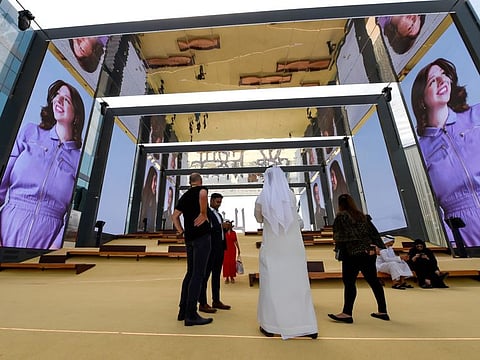Watch: Inside Israel’s ‘open tent’ pavilion at Expo 2020 Dubai
Designed without walls, Israel Pavilion signifies openness, diversity and inclusiveness

Also In This Package
Dubai: A very striking and interesting feature of the Israel Pavilion at Expo 2020 Dubai is that it is open – literally. There are no walls at the front and back, and the sides are made of LED walls, creating a see-through effect.
“Israel Pavilion is a welcoming, open pavilion – where everyone is invited,” Menachem Gantz, spokesman of the Israel Pavilion, told Gulf News during a media tour on Monday, ahead of the official opening of Expo 2020 Dubai on October 1.
Israel Pavilion is located at Expo’s Opportunity District, and situated between the pavilions of India and Italy. Creators of the Israel Pavilion explained the ‘open tent’ concept is meant “to showcase Israel as an open and diverse society that provides equal rights to all its inhabitants. It is also an open invitation to collaborate and address various world challenges”.
Officials noted visitors to the pavilion will be taken through a journey of Israel’s past, present and future – with emphasis on a journey towards tomorrow and highlighting Israel’s innovation in agriculture, water, medicine, communications and cyber-technology.
The pavilion’s open-tent concept also provides a clear vision and open horizon in dealing with the challenges of humanity as well as recognising diversity and respecting different cultures.
Thankful to the UAE
Gantz told Gulf News: “We thank the UAE, the host country, for giving us the opportunity to be here at the Expo. This opportunity means a lot as it brings future generations towards tomorrow. There are so many things that unite, much more than divide us – and we see many fields of collaboration here that will create a better future for generations to come.”
He added: “Since being invited to participate in the Expo, Israel has been looking forward to forging new relationships with countries across the region and showcasing both its cultural similarities as well as its innovative contributions to global issues. Many exciting developments have occurred since the UAE extended the invitation to Israel to participate in Expo 2020 Dubai, such as the signing of the Abraham Accords, building bilateral trade successes as well as showcasing shared cultures between the UAE and Israel.”
He noted that a year into the historic Abraham Accords, some $570 million in business has been done between Israel and the UAE, and trade between the UAE and Israel could reach $1 billion (around Dh3.67 billion) this year, with a potential to exceed $3 billion in three years.
Desert dunes
Israel Pavilion is full of symbolism. Aside from the open tent, another eye-catching design is the desert dunes. From the ground level, one will climb up sand dunes to enter the main hall.
“Desert dunes are common to the UAE and Israel, said Gantz, adding: “Israel’s participation in the Expo is an important part of building the relationship between the two countries. The Expo is an opportunity for all nationalities to get to know and learn from one another. People often forget there is much more uniting us than dividing us, which is what we want to highlight at the Expo.
“From the architecture of the pavilion to the content on display, this is one of the messages that we want to share with visitors. The Expo lands, for the first time, in the Middle East and we are a part of this region, so we are welcoming all in joining us in this journey towards tomorrow.”
Multi-sensory journey
Once inside the main hall, one will notice seven large LED screen-walls that feature a spectacular video presentation about Israel that visitors can interact with. The LED screens will also display images and videos tackling world hunger, protecting the environment, clean energy, water conservation and adaptation for arid countries, health technologies and cyber security.
The dune level is also equipped with virtual-reality binoculars, allowing visitors to virtually experience tourist sites in Israel from its pavilion at the Expo.
The multi-sensory journey continues when one goes inside the 360-degree room, below the sand dunes, where “visitors will be able to hear, see, and personally feel Israel” via a multi-sensory, high-octane panoramic audio-visual presentation.
Music is also major element in the vibrant cultural programme at the Israel Pavilion. Maestro Tom Cohen, founder, chief conductor and musical director of The Jerusalem Orchestra East and West, made a fusion of Eastern and Western music that harmoniously blended traditional with modern and upbeat electronic music.
“The melody aims to be simple and catchy and rather than being from any one place, is neither Jewish or Muslim, Arab nor European, but rather unites all of them,” said Josh Bendit, director of the Israel Pavilion.
'Towards tomorrow'
Israel Pavilion is both simple and emblematic – there are no frills but every corner is illustrative of the Expo spirit. The pavilion incorporates numerous technologies but it is also full of human elements, aimed at engaging visitors from the sensory to emotional levels.
The most important message of the pavilion can be found at the pinnacle. Written in Aravrit, a stylised writing system created by Israeli typography designer Liron Lavi Turkenich that merges Arabic and Hebrew, is the strong message, ‘Towards Tomorrow’.
The message is presented in a three-dimensional statue written in Aravrit to allow both Arabic and Hebrew speakers to read the same words and understand the same messages that promotes peaceful co-existence and common desire to work for a better tomorrow.
Sign up for the Daily Briefing
Get the latest news and updates straight to your inbox








